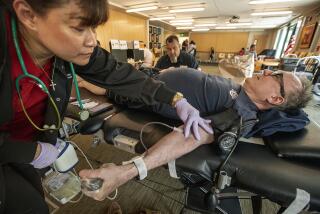Marrow Donors: Two-Way Benefit
- Share via
BALTIMORE — “When I was in college, I took a CPR (cardiopulmonary resuscitation) course,” John Coliton recalls. “I walked out afterward thinking, ‘Boy, this is great! I can save somebody’s life.’ I spent a year waiting for someone to choke so I could do the Heimlich maneuver on him. Luckily, it never happened.”
In November, Coliton, a computer programmer here, saved somebody’s life in another way: He donated bone marrow.
It was removed surgically from inside his pelvic bones, then taken to Seattle, where a boy he had never met was hospitalized with a form of leukemia for which a marrow transplant was the only hope of cure.
Coliton was located through a file of possible marrow donors started two years ago by the National Bone Marrow Donor Program, headquartered in St. Paul, Minn.
“As to why I got on the list . . . I feel it’s something I can do to help the community,” he says.
Donating bone marrow is a complicated procedure, requiring overnight hospitalization, anesthesia, needle punctures through flesh and into the pelvic bones, and, for about three days afterward, pain-killing medication. The few ounces of marrow he lost have since been replaced by his body.
For the recipient, however, the procedure is much more difficult.
Seriously ill with leukemia, aplastic anemia or other disorders involving the blood-forming bone marrow, the patient must have his own bone marrow destroyed by chemotherapy or radiation, or both. The donor marrow is then infused, like a blood transfusion; it has to migrate to the hollows of the bones, replicate itself and go to work.
Tissue matches are never perfect except between identical twins. Thus it is possible that immune system components manufactured by the donor marrow will recognize the recipient’s body as foreign and mount a life-threatening attack, in a condition known as “graft vs. host disease.”
But when transplant works--as it does 30% to 80% of the time--it’s worth the struggle.
“If successful, bone marrow transplant cures the disease,” says Pamela Weinberg, director of community development for the National Bone Marrow Donor Program.
The registry, she says, now contains about 62,000 names, from which 250 matches have been made. “We manage to find a donor for about 15% of the patients who contact us,” she adds.
But for most people in need, the registry is a last resort. The best chance of a match is within a family; next best is someone within one’s own ethnic group.
Most of the volunteers on the registry are of Northern European Caucasian background; potential recipients who are also of this background have a one in 20,000 chance of finding a match on the list. Minorities are poorly represented on the registry; minority recipients, therefore, have a poorer chance of finding a donor.
Research has shown that more than just personal concern motivates most donations, Weinberg says. “What we’re finding is that these are people whose lives have been touched in some very painful way by cancer: A parent, child, husband, wife, brother, sister has died, and they felt so powerless. Now they want to feel there’s something they can do to have some power over it.
“Or, they feel they’ve been blessed, or lucky, with personal health.
“Or, they’ve grown up feeling that sharing what they have is important; they have a history of sharing and caring for others.”
Michael Elman, assistant professor of ophthalmology at the University of Maryland and Johns Hopkins medical schools, puts it more simply: “It’s a mitzvah, “ to save a life, he says, using the Hebrew word that translates as both “commandment” and “good deed.”
“It makes people feel good,” he continues. “Maybe that’s the motivation.”
Which is what Coliton says.
“I can make a positive impact on another human being. Wow! That’s wonderful. It makes me feel great!”






